Bauma Interview: Tim Burnhope, JCB
01 May 2025
JCB’s Tim Burnhope covers company plans to offer full powertrains, the future fuel mix for construction machines and building a second assembly plant in the United States
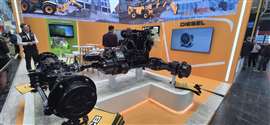 JCB stand at Bauma 2025 featured a full diesel powertrain (Photo: Power Progress International)
JCB stand at Bauma 2025 featured a full diesel powertrain (Photo: Power Progress International)
JCB is known around the world as an OE manufacturer of engines and complete off-highway construction machines covering virtually every application type. But at Bauma 2025, rather than engines or machines (other than the company’s new hydrogen internal combustion (IC) engine) the stand instead featured a full drivetrain, complete with engine, axles, power tube and transmission.
Speaking with Power Progress International, Tim Burnhope, group director of Special Projects, said that this could be a growth direction for the company. “We’ve obviously got the engines and for many years we’ve done the transmissions and axles. People are very interested in the overall drivetrains and I think it works well, there are more companies now looking to have the full solution.
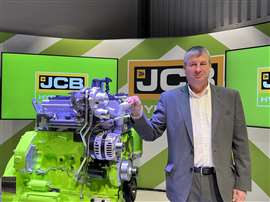 JCB’s Tim Burnhope (Photo: JCB)
JCB’s Tim Burnhope (Photo: JCB)
“If you’ve got the most efficient engine, the most efficient transmission, the most efficient axle, it makes sense that the company manufacturing those products can combine them in the most efficient powertrain.”
Asked which companies will likely be the customers looking to benefit from such a service, Burnhope notes that there are “a number” now working with JCB. He says that the possibility of JCB offering complete powertrains is creating some excitement in the market, as is the new hydrogen engine.
Hydrogen rationale
The decision to feature a full powertrain using a diesel IC engine on the JCB stand was a little surprising, particularly with the hydrogen IC engine prototype also on show. But look a little deeper and the reasoning becomes clear; where hydrogen was the focus at Bauma 2022, three years later electrification was the star of the show.
With that in mind, the case for hydrogen as a fuel for construction machines needs to be carefully managed so it is not dismissed out of hand.
“When it comes to hydrogen and rationalising the use case, you have to start with the job site and work back from there. The case for hydrogen is much more compelling from that perspective,” explained Burnhope.
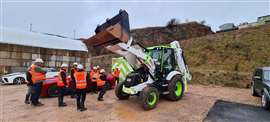 Hydrogen power - the JCB H2 IC engine has been in development since 2021 (Photo: Power Progress International)
Hydrogen power - the JCB H2 IC engine has been in development since 2021 (Photo: Power Progress International)
“The global population will be growing in regions outside Europe and unlike here, a lot of this growth will involve greenfield projects – there’ll be no infrastructure, no power cables. But what a lot of those countries have is solar power and that electricity can be used to produce hydrogen on the site.”
Continuing, he put forward the case of Neom, the mega construction project in Saudi Arabia which includes such elements as horizontal skyscraper known as The Line and a mountain holiday retreat called Trojena. Across each of these locations the plan is for the infrastructure to be self-sustaining in terms of energy, which could see electricity from renewable solar and wind used to produce hydrogen.
“That will work well in places like Saudi Arabia. But in Britain, where the sun doesn’t always shine and there’s not always any wind, stored renewable electricity can be used to produce green hydrogen to deliver power where and when it’s necessary,” added Burnhope.
He continued: “I don’t say it’ll be one energy source or another across the entire industry, but we’re likely to see different energy sources for different applications, electric for compact machines, hydrogen for larger machines and perhaps biofuels for the very large mining and quarrying machines. It’s all about using the right energy type to deliver what’s needed.”
As with every new energy choice, it’s impossible to accurately predict future demand for hydrogen technology. With that in mind, the hydrogen internal combustion engine developed by JCB can be produced in any sequence and in any volume on the same assembly line delivering the four-cylinder 55 kW diesel engine on which it is based.
Likewise, machines on the same assembly line can be fitted with either diesel or hydrogen engines, as Burnhope explained: “It’s very similar to engine manufacturing. Where we are producing backhoe loaders, instead of dropping in a traditional diesel engine and fuel tank the machines can be fitted with a hydrogen pressure tank, the fuel delivery system and the H2 engine on the same line.”
Electric power costs
JCB currently produces nine different lines of pure electric machines, including mini excavators, compact dumpers and telehandlers. According to Burnhope, the company recently passed 35,000 unit sales across all electric machines.
The machines are ideal for use on construction sites where there is access to electricity, or they can be taken back to a depot for charging; given the right connection, recharging is quite rapid. They are also very quiet, which supports work on enclosed urban sites and underground locations.
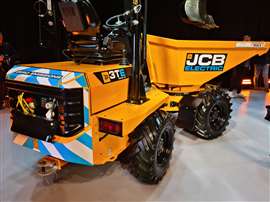 Electric power for compact machines - the JCB 3TE electric dumper (Photo: Power Progress International)
Electric power for compact machines - the JCB 3TE electric dumper (Photo: Power Progress International)
While smaller machines lend themselves to battery power, using the same tech for larger applications raises a series of issues. Battery pack size, recharging and purchase cost are all prohibitive.
Burnhope: “It all sounds very good, having the capability to recharge in an hour. But sometimes you can’t get power delivered at that level, plus you need a pretty heavy cable to support charging at those rates. That’s when you end up with diesel generators on site, which defeats the objective.”
He continued by outlining the following use case: “A 20-tonne electric excavator can have between 200 and 400 kWh of batteries. One scenario we’ve modelled is where you have a machine like this that supports battery swapping, but you need a 16-tonne truck to carry the eight tonnes of batteries to and from where they’re charged. Plus you need another set of batteries on charge and at least two operators. Including the cost of the excavator, you could be looking at around £1 million, where a diesel version of the same machine is about £150,000.”
With that in mind it’s easy to see that, unless absolutely necessary, the cost/benefit of large electric machines does not add up.
Crunching numbers
The above scenario only takes into account the upfront cost of larger electric machines and their support hardware. Clearly, the existing infrastructure gives diesel an advantage. But proponents of electric machines put forward that while they are expensive to buy, the lower cost of electricity over diesel (in some areas) will see the advantage swing back to battery models over a machine’s working lifetime.
“When it comes to hydrogen and rationalising the use case, you have to start with the job site and work back from there” Tim Burnhope, JCB
“I think total cost of ownership numbers are good, but that doesn’t take into account some of the challenges,” said Burnhope. “Residuals are important. And that is impacted by the expected number of recharging cycles. For mini electric machines, those batteries will last a long time. For larger machines, prospective customers are asking if they will need to buy new lithium batteries in 10 years and that would be expensive.
“That’s why machines with lead-acid batteries were popular – the batteries didn’t offer a great run time and they would wear out, but they were cheap to replace.”
New plant investment
Moving on from machine power, the conversation turned to plans for machine production in the United States. In 2024, JCB announced that it was to invest $500 million to develop a new 67,000 square metre plant in San Antonio, Texas. Joining the existing JCB plant in Savannah, Georgia, the new factory will be the company’s second largest behind the headquarters in Rocester, UK.
The new plant was always meant to produce machines for the North American market, but with the changing policies brought in by the Trump administration the investment decision seems even more fortuitous.
“It’s really exciting!” said Burnhope. “We were already working on the facility, the planning and where to position different functions. But based on the policy direction in the United States, we might have to consider increasing the size of the plant again.”
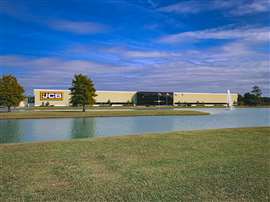 JCB plant in Savannah, GA will be joined by a second factory in Texas (Photo: JCB)
JCB plant in Savannah, GA will be joined by a second factory in Texas (Photo: JCB)
As it stands, there haven’t been any announcements as to what the new plant will produce. Although while the locations in Savannah and Texas are of a similar size, new assembly procedures and hardware could result in the Texas plant having a higher overall annual output than the Georgia location.
Interestingly, there are some minor differences between machines of broadly the same type produced in Europe and the US. Burnhope noted that, for example, telescopic handlers in Europe have a lower boom which allows the driver to see over smaller loads such as brick packs. In the US, the boom is higher to accommodate larger items, such as complete timber A-frames used in housing construction.
Looking at engines, while the US remains largely powered by diesel, Texas particularly has made investments to support large-scale hydrogen production, which was of interest to JCB.
As for whether new tariffs would impact future business decisions, Burnhope had this to say: “We need to continue to negotiate and work out the best solution. That’s the focus, together with serving our customers in America.”
Hydrogen machines get highway green light
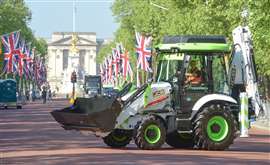 On The Mall - JCB’s hydrogen digger (Photo: JCB)
On The Mall - JCB’s hydrogen digger (Photo: JCB)
In April, the UK government signed a ‘statutory instrument’ which allowed hydrogen-fuelled construction and agricultural machinery to use public roads across the UK.
To mark the occasion, JCB drove an H2-powered digger around various iconic London landmarks, including The Mall (which leads to Buckingham Palace, see photo) and the Houses of Parliament.
Speaking about the new law, Future Roads Minister Lilian Greenwood, said: “We’re supporting the UK’s Plan For Change by working closely with brilliant British companies like JCB to harness the opportunities of the net-zero transition, driving innovation and creating jobs to put monty in the pockets of hardworking people and secure our future.”
The amendment to the Road Vehicles (Construction and Use) Regulations 1986 will help with the movement of machines powered by hydrogen, where they would have otherwise needed trucks to switch locations.
POWER SOURCING GUIDE
The trusted reference and buyer’s guide for 83 years
The original “desktop search engine,” guiding nearly 10,000 users in more than 90 countries it is the primary reference for specifications and details on all the components that go into engine systems.
Visit Now
STAY CONNECTED




Receive the information you need when you need it through our world-leading magazines, newsletters and daily briefings.
CONNECT WITH THE TEAM









